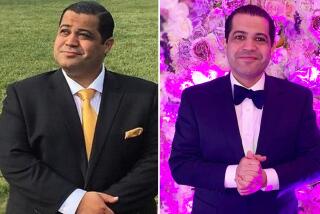He Gets Body Lift at 40 : Zeigman Battles Middle Age, Young Conans With 4-Year Training Regimen
- Share via
Shortly before he turned 40, Steve Zeigman looked in the mirror and saw a couch potato in the making.
Middle age was overtaking the body that had once looked like Rambo’s, that had been strong enough to win national weightlifting titles. There was a lot of fat where muscle once was. There was a lot of stomach hanging over his belt. There was a lot of wheezing when he walked up stairs.
“I was disgusted with what I’d become,” Zeigman said. “It was not satisfactory.”
So Zeigman vowed to get back in shape.
That was 16 months ago. Zeigman has redefined his body as well as his goals. Now he wants to make the U.S. Olympic team in 1992.
“I’m going to be the oldest American weightlifter in history to qualify for the Olympics,” he said.
Zeigman, who will be 44 at the time of the Barcelona Olympics, is asking his body to respond as it never has, even when he was younger. In 1970, Zeigman, weighing 148, was the first American to lift double his body weight in the press. To make the 1992 Olympics, the 5-foot 5-inch Zeigman, now weighing 186, says he’ll have to snatch 330 pounds and lift 420 in the clean and jerk.
“There are no international lifters my age,” Zeigman said. “It’s high-level and intensely brutal competition.”
The oldest lifter on last year’s American team was 31. So does Zeigman stand a chance?
“I don’t really think so,” said Jim Schmitz, U.S. Olympic coach last year and president of the U.S. Weightlifting Federation, governing body of the sport. “As you get older, you don’t get stronger. In recent years, weightlifting has become more of a young man’s sport. You don’t see 40-year-olds defeating 30-year-olds.”
But Zeigman, who lives in North Hollywood, will not be put off.
“I’m a great athlete who’s getting better every year,” he said. “We’re living in a scientific age. I’m applying myself in more scientific ways than other lifters.”
As an athletic trainer who owns his own gym, Zeigman believes that he is in a position to know all the latest training innovations and have time enough to apply them to his own body.
Six months ago, Zeigman opened the Biofitness Health Center in Northridge. Working with several physicians, he does physical therapy and “fitness enhancement” on patients, but also gets in his own daily and often twice-daily workouts with weights.
Zeigman unrolled a long computer printout, his training regimen. He says it’s a pirated version of a program the Soviets developed for a 21-year-old lifter.
“The program runs through 1992 and I’m dedicated to it,” he said.
Zeigman, who is certified as an active trainer by the American Athletic Trainers Assn. in Arcadia, said he will also use nutritional supplements and legal drugs, avoiding steroids, which are banned in the Olympics.
Zeigman was standing in the front room of his health center in a small shopping mall. On a wall were letters from people he has helped train or rehabilitate, including former light-heavyweight boxing champion Dwight Muhammad Qawi. Muzak was playing.
“This is no disco gym,” he said.
A potential patient called on the phone and Zeigman told him, “No matter if you’re deconditioned or hurt, I can help you.”
Although a 5-week program costs $500, most of Zeigman’s 40 patients are ordered into therapy by a physician and get their treatment paid for by health insurance. First-time patients are given a physical by a doctor and then put into Zeigman’s care. He uses standard equipment, such as ultrasound and diathermy, but also has an electronic muscle stimulator that he claims increases strength by 20% and a climbing machine that he claims improves cardiac endurance by 20%.
“At the same time patients are getting healed, they’re getting fit,” Zeigman says.
Ann Hodges, a part-time aerobics instructor, was lying on a trainer’s table, hooked up to the muscle stimulator, her thigh and stomach muscles twitching involuntarily.
“I can tell I’ve had a workout,” Hodges said, her brow sweating.
In front of her was a television set and a VCR on which she could watch subliminal videotapes to build confidence.
Zeigman uses the climber and muscle stimulator as an adjunct to his own weight training.
“I’m training harder today than I trained at 21,” he said. “No one back then worked out 6 or 7 days a week.”
Growing up in the Washington (D.C.) area, Zeigman started lifting in high school, winning the teen-age nationals his senior year. In 1969, he was third in the U.S. national competition, then won it a year later with a lift of 301 pounds, more than 16 pounds better than the American record.
But then he quit because of his father’s failing health “and a lot of emotional distress at home,” he said.
In 1982, to fill the “vacuum in my life,” he took up the sport again, and 6 months later qualified for the nationals. But in a workout shortly before the meet, he suffered a major muscle injury and wasn’t able to lift for 3 years. By the time he was healed, he had lost his drive, or had at least misplaced it.
“I got back into weightlifting a few months ago, not just because of the way I looked,” Zeigman said. “There were people I defeated who went on to the Olympics. I’m better than they are and I don’t think I’m too old to compete. A lot of people are going to be surprised.”
More to Read
Go beyond the scoreboard
Get the latest on L.A.'s teams in the daily Sports Report newsletter.
You may occasionally receive promotional content from the Los Angeles Times.






